- Travel + Photos
- Voyages
- Japan
A Cultural Taste of Japan

What did I know of Japan before this trip? The samurai, sumo wrestling, sushi/sashimi, animés, cars, electronic gadgets... not much really. Thus I tried to discover the most I could in hope of getting a glimpse of the traditional side in this modern Japan. I did not have a set itinerary, just some must-see cities, but in the end, what I ended up visiting was more or less the classical cultural circuit of Japan that most people do.
Miyajima (宮島)
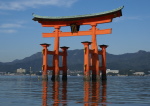 Miyajima, literally the "shrine island", is the common name for the island of Itsukushima, which is about half an hour south west of Hiroshima. For most of the history of Japan, the island is considered a sacred place; women and commoners were not allowed to set foot on the island. Likewise, old people were transported off the island to die in order to preserve the ritual purity of the place. Even nowadays, no cemetery is permitted on the island. Strict measures have been taken in order to ensure that the town will keep its Edo period look.
Miyajima, literally the "shrine island", is the common name for the island of Itsukushima, which is about half an hour south west of Hiroshima. For most of the history of Japan, the island is considered a sacred place; women and commoners were not allowed to set foot on the island. Likewise, old people were transported off the island to die in order to preserve the ritual purity of the place. Even nowadays, no cemetery is permitted on the island. Strict measures have been taken in order to ensure that the town will keep its Edo period look.
The main attraction on the island is the Itsukushima Shrine and its floating torii. I was lucky enough to witness a traditional Shinto wedding taking place at the shrine during my visit there. Not wanting to let my chance of taking pictures of the couple in their beautiful traditional wedding dress go by, I kind of followed them inside (very discretely of course). At the end of the ceremony, the priest performed a ceremonious dance. I couldn't quite understand the meaning of the dance, but it was sure a spectacle in itself. For a better view of the shrine, try to time your visit with the high tide when the shrine and the torii are submerged in the water, or at night when they are illuminated.
Hiroshima (広島)
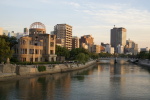 Hiroshima, founded in 1589, became an important urban centre during the Meiji period. During the first Sino-Japanese war, Hiroshima became a strategic military centre, and later became an industrial centre of importance. Its importance was one of the reasons why it was chosen as a target for the atomic bomb during World War II.
Hiroshima, founded in 1589, became an important urban centre during the Meiji period. During the first Sino-Japanese war, Hiroshima became a strategic military centre, and later became an industrial centre of importance. Its importance was one of the reasons why it was chosen as a target for the atomic bomb during World War II.
At 8:16 AM local time on August 6th, 1945, after 43 seconds of free fall, the atomic bomb exploded 600 m (1968 ft) above ground and instantly erased the city. The Atomic Bomb Dome (or Genbaku Dome) is one of the rare structures to survive the explosion (mainly because it was almost directly at the hypocentre of the explosion) and has been conserved as-is as a reminder of the nuclear devastation.
Not to be missed is the Peace Memorial Museum where one can learn in details the devastating effect of the atomic bomb - very moving. Within the Peace Memorial Park, there is the Children's Peace Monument where numerous paper cranes are displayed. The story goes something like this. In 1955, a young girl, Sadako Sasaki, became very ill as the result of the atomic bomb's side effect. Her best friend told her then the old Japanese legend of the thousand cranes, according to which one who folds one thousand origami cranes is granted a wish. She started the task hoping that the gods would allow her to heal and start running races again once the thousand cranes are made. But she died October 25th, 1955 at the age of 12 after having folded 644 paper cranes. Her story has a profound impact on her classmates who finished the thousand cranes and continued on to raise money in order to build a statue to the honour of Sadako and of all the children affected by the bomb.
Being reborn and rebuilt from ashes, Hiroshima is nowadays a modern and dynamic city as can be attested by its shopping arcade. Hiroshima is now the industrial centre of the Chugoku-Shikoku region. The city has a kind of relax character that I like; it is big enough to be animated, but not enough to have crowding problems.
Himeji (姫路)
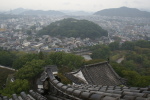 The castle of Himeji, Himeji-jõ, is one of the oldest structures of medieval Japan and is considered by most as the most magnificent wooden castle still standing in Japan. It is also occasionally known as Shirasagi-jõ (literally "white heron castle") because of its brilliant white exterior.
The castle of Himeji, Himeji-jõ, is one of the oldest structures of medieval Japan and is considered by most as the most magnificent wooden castle still standing in Japan. It is also occasionally known as Shirasagi-jõ (literally "white heron castle") because of its brilliant white exterior.
The origin of the castle goes back to the Nanbuko-shu era of the Muronachi period, around 1346. The castle has been expanded and remodelled throughout the years by its successive occupants. The current keep with its five-storey tower dates from 1609. Being built as a defence fort, the castle has a confusing maze of paths leading to its main keep. The inside of the donjon does not exhibit any refined decoration but rather, it has massive rustic wooden posts and floor. Going up the tower can be a delicate task because of the narrow and steep stairs, specially the ones leading to the top level. The view from the top of the donjon is beautiful (despite the torrential rain the day of my visit) and very interesting with the architecture of the roof as foreground and the city at distance.
Nara (奈良)
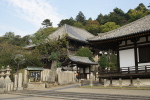 Nara was the capital from 710 to 784 and the first true permanent capital of Japan. Indeed, according to old conceptions of Shintoism, death constitutes the worse impurity, thus when death strikes the sovereign, the palaces must be destroyed and rebuilt somewhere else. That practice diminished with the influence of Buddhism. At the beginning of the 8th century, it was decided that a permanent capital be built for the stability of the government and the State administration.
Nara was the capital from 710 to 784 and the first true permanent capital of Japan. Indeed, according to old conceptions of Shintoism, death constitutes the worse impurity, thus when death strikes the sovereign, the palaces must be destroyed and rebuilt somewhere else. That practice diminished with the influence of Buddhism. At the beginning of the 8th century, it was decided that a permanent capital be built for the stability of the government and the State administration.
The city may look uninspiring at first glance, but with eight UNESCO World Heritage sites, Nara is second only to Kyõto as a repository of Japan's cultural legacy. Most of those monuments are within the Nara-kõen area. Not to be missed is the Buddhist temple Tõdai-ji with its famed Daibutsu (Great Buddha), a bronze statue of 16 m (52 ft) in height.
Kyõto (京都)
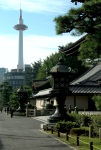 When a priest by the name of Dõkyõ managed to seduce an empress and nearly usurp the throne, the emperor decided to move the capital to a new location, out of reach of Nara's increasingly powerful Buddhist clergy. The new city, Heiankyõ (lit. "tranquility and peace capital"), became the seat of the imperial court in 794 and later was renamed to Kyõto ("capital city"). Kyõto remained the imperial capital of Japan until 1868 when the Meiji Restoration relocated the imperial family to the city of Edo.
When a priest by the name of Dõkyõ managed to seduce an empress and nearly usurp the throne, the emperor decided to move the capital to a new location, out of reach of Nara's increasingly powerful Buddhist clergy. The new city, Heiankyõ (lit. "tranquility and peace capital"), became the seat of the imperial court in 794 and later was renamed to Kyõto ("capital city"). Kyõto remained the imperial capital of Japan until 1868 when the Meiji Restoration relocated the imperial family to the city of Edo.
In my mind, the image of the ancient Japan (the geishas, women in kimonos, old houses and temples etc.) is associated with Kyõto for some reasons. It was therefore the city I wanted to visit before setting foot to Japan. I did find those typical images in Kyõto. I saw more women in kimono in the streets than I expected - perhaps because I was there during the Jidai Matsuri festival, or perhaps because of the incentives for wearing a kimono such as store or taxi fare discounts. I was lucky enough to see some geishas (or maybe maikos) and they were kind enough to pose in picture for me. The old houses are like I imagined and the temples and shrines are even more impressive than on pictures.
In fact, I made the grave error of trying to visit as much temples and shrines as possible (considering their number, it would take months, if not years, to visit them all) as it made my visit of Kyõto very tiring. The crowd there made it even worse. I must say that autumn is the high tourist season of the Kansai region; the weather is clement (not too hot, not too cold) and the leaves start turning red, which Japanese tourists take advantage of and pack the historical sites. It was very strange for me to see the enormous crowd in the temples and gardens, which in my mind are associated with tranquillity and meditation.
The big surprise for those not expecting it, is at the exit of the Kyõto train station. Most travellers arrive to Kyõto by train, hence the train station is the first view of the city for them, and that view is nothing like an ancient city that one would expect. Indeed, the train station is an ultra modern building with metallic structures and mirror faces. Some stairs outside also double as stadium seating for concerts. The train station to Kyõto is like the pyramid to the Louvre, either you like it or you don't. But one thing is for sure: it is part of recognizable landmarks of the city.
Takayama (高山)
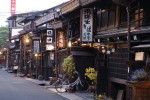 After the crowd in Kyõto, I needed to relax and recharge and I found the perfect place for that in a small town at the foot of the Japanese Alps called Takayama (literally "high mountain") in the Hida region. The town is laid-back and its habitants are very friendly. With preserved old inns, traditional shops and sake breweries, Takayama is a rarity: a city that has managed to retain its traditional charm. Wandering in the old Sanmachi Suji district, one can easily imagine how a town in the ancient Japan looks like.
After the crowd in Kyõto, I needed to relax and recharge and I found the perfect place for that in a small town at the foot of the Japanese Alps called Takayama (literally "high mountain") in the Hida region. The town is laid-back and its habitants are very friendly. With preserved old inns, traditional shops and sake breweries, Takayama is a rarity: a city that has managed to retain its traditional charm. Wandering in the old Sanmachi Suji district, one can easily imagine how a town in the ancient Japan looks like.
The town is renowned for its background in carpentry. In feudal Japan, the regions had to pay taxes in rice, which posed a problem for the Hida region, with little farrmland but many forested mountains. So in lieu of taxes, Hida was permitted to send its woodworker to construction sites all over Japan, including construction of Nara and Kyõto. Thus carpenters from Takayama are amongst the best in Japan.
Kamakura (鎌倉)
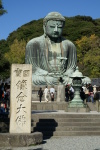 Kamakura is a small seaside town located 50 km (31 miles) south-west of Tõkyõ. The city gained its importance in Japan when shogun Minamoto no Yoritomo established his shogunate in Kamakura in 1192, thereby starting the Kamakura period (1185-1333). Nowadays, the city is a popular tourist destination for Tokyoists (it is better to visit on a weekday in order to avoid the crowd). Kamakura is famous for its many temples and mausoleums, and specially for the Great Buddha Amitabha. The Daibutsu is a bronze sculpture of about 13 m (42 ft) high, dating from around 1252.
Kamakura is a small seaside town located 50 km (31 miles) south-west of Tõkyõ. The city gained its importance in Japan when shogun Minamoto no Yoritomo established his shogunate in Kamakura in 1192, thereby starting the Kamakura period (1185-1333). Nowadays, the city is a popular tourist destination for Tokyoists (it is better to visit on a weekday in order to avoid the crowd). Kamakura is famous for its many temples and mausoleums, and specially for the Great Buddha Amitabha. The Daibutsu is a bronze sculpture of about 13 m (42 ft) high, dating from around 1252.
Nikkõ (日光)
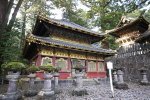 About 150 km (93 miles) north of Tõkyõ, at the foot of the Tochigi mountains, is located the small town of Nikkõ (literally "sunlight"), famous for its shrines and temples. In 766, Shõdõ Shõnin, a buddhist priest, established the first temple in Nikkõ, followed by another one in 784. The village of Nikkõ developed around these temples. The town became famous when shogun Tokugawa Ieyasu was buried there in 1617 and when later his grandson, Iemitsu, built the Tõshõgu mausoleum for him in 1634. Nowadays, Nikkõ is a very popular destination for Japanese and international tourists.
About 150 km (93 miles) north of Tõkyõ, at the foot of the Tochigi mountains, is located the small town of Nikkõ (literally "sunlight"), famous for its shrines and temples. In 766, Shõdõ Shõnin, a buddhist priest, established the first temple in Nikkõ, followed by another one in 784. The village of Nikkõ developed around these temples. The town became famous when shogun Tokugawa Ieyasu was buried there in 1617 and when later his grandson, Iemitsu, built the Tõshõgu mausoleum for him in 1634. Nowadays, Nikkõ is a very popular destination for Japanese and international tourists.
The Tõshõgu shrine was built to illustrate the wealth and power of the Tokugawa clan. The buildings of the shrine are therefore sumptuous with lavish decorations, vibrant in colours and of grand liberty of expression. Amongst the adornments are the famous wood carving of the sleeping cat (Nemuri-neko) and three wise monkeys. There is also a wonder of architecture within the shrine complex: a five-storey pagoda with no foundation, suspended on a pole like a pendulum in order to avoid the effects of earthquakes.
Iemitsu's mausoleum, Taiyunin-Byõ, is in some way a smaller version of Tõshõgu, but not any less impressive nevertheless. Fatarasan shrine and Rinnõ-ji temple, both founded by Shõdõ Shõnin in 767 and 782 respectively, along with the aforementioned mausoleums, are listed under UNESCO World Heritage since 1999 and are amongst the most beautiful monuments I have seen in Japan.
Tõkyõ (東京)
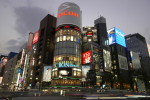 Tõkyõ literally means "eastern capital", as opposed to the previous capital, Kyõto, located to the west. Its old name is Edo, "estuary" or bay-door, a small village that was made the military and administrative capital in 1603 by the shogun Iegasu Tokuguwa, thus inaugurating the Edo period, also known as the shoguns era. Edo became the capital in 1868 and was renamed to Tõkyõ. Since the Edo period, the city has gone through a devastating incendiary, earthquakes and the bombardments of World War II, hence its number of historical monuments is not as significant as that of Kyõto or Nara.
Tõkyõ literally means "eastern capital", as opposed to the previous capital, Kyõto, located to the west. Its old name is Edo, "estuary" or bay-door, a small village that was made the military and administrative capital in 1603 by the shogun Iegasu Tokuguwa, thus inaugurating the Edo period, also known as the shoguns era. Edo became the capital in 1868 and was renamed to Tõkyõ. Since the Edo period, the city has gone through a devastating incendiary, earthquakes and the bombardments of World War II, hence its number of historical monuments is not as significant as that of Kyõto or Nara.
In my mind, Tõkyõ is like New York: a big modern metropolis with a dense population. I had no desire to rub shoulders with the crowd in the street, and specially to be crammed like sardines in the subway of Tõkyõ. In short, Tõkyõ was not high on my list of cities to visit. To my surprise, the visit was more pleasant than I expected. I still don't know why; perhaps because I stayed in the Asakusa area close to the Senso temple where it is very animated and there are a lot of reasonably priced good restaurants, or perhaps because the city is a great photographic subject. I now see why the city could be a paradise for those who love night life, shopping and electronic gadgets.
The Cuisine
In short, Japanese cuisine is varied and delicious. On this trip, I discovered a lot of Japanese dishes that I didn't know about. I also had confirmation that in general, sushi is better in Japan and have found some variety of sushi that I have never seen nor tasted before.
For me, the best way to try out the Japanese cuisine was dining at small local restaurants. Often, I chose a restaurant based on the number of local people dining there. The down side is that in general, those restaurants don't have an English menu and their waiter don't speak English. However, most have pictures menus, and some have plastic dishes displayed at the window, in which case I took the waiter out to show which dishes I wanted to order. As for restaurants that only have Japanese menus, I had learned to recognize kanji characters for numbers so to know the prices, then I randomly chose the dishes based on price. Only once during the entire trip that I ordered something that was not to my liking (and I still don't know what it was since it was in Japanese).
The People
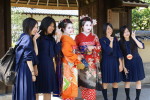 In general, Japanese are very polite and considerate. I never saw anyone yelling or arguing in the street during my trip. Japanese are obsessed with their mobiles: they spend their time texting or doing something with their mobile, even while bicycling. However, no one talks on the phone in the street or in public places like on the train and bus.
In general, Japanese are very polite and considerate. I never saw anyone yelling or arguing in the street during my trip. Japanese are obsessed with their mobiles: they spend their time texting or doing something with their mobile, even while bicycling. However, no one talks on the phone in the street or in public places like on the train and bus.
The society seems very organized. In the subway, like in train stations, there are lines on the platforms indicating where train doors are; people align on both sides of the marking (and therefore of the doors when the train arrive), wait for people from the train to get off before getting on the train. Likewise, at bus stops, people get in line while waiting for the bus so that the first person in line would get on the bus first. Trains always arrive in time, almost to the second. Everything works like a well oiled clock.
The crowd in big cities is very impressive, specially in Tõkyõ where the crowd is much bigger than that in New York or Paris. At Tõkyõ train station, one of the busiest stations, the crowd arrives in waves, at the rhythm of trains and subways arrival. Since most people are in black business suit, the visual effect is like black tidal waves. Likewise, it is like a sea of people in Shibuya on the weekend, a spectacle to be seen in itself. Despite the fact that my tripod is black and thus difficult to discern at night, no one has hit my tripod nor me during the almost hour I spent in the middle of that huge crowd to take night pictures of Shibuya. That is what I call the "organized chaos".
Two weeks in Japan is sure not enough to get to know the country and people. But the little cultural taste that I have savoured gave me a glimpse of the ancient Japan that I have always wanted to discover.
Practical Details
Dates of my stay in Japan: 15-31 October 2007
Just like in Europe, the train system is very well developed in Japan. One can take the train to go almost anywhere in the country. There are several private train networks in Japan, the biggest being that of Japan Rail Group (JR). If you intend to take the train often, consider buying the Japan Rail Pass. Some restrictions are applied with the pass, but it is a practical and economical way to visit Japan.
Sleeper trains of the JR are quite comfortable (at least for me) and it is a good way to save on a night at the hotel. Also, try to memorize the kanji characters of your destination name because not all stations have their name displayed in romanji.
In Japan, one boards the bus from the back and gets off by the front door where one pays the fare.
Some restaurants have a kind of automatic distributor with dishes photos and prices on the outside. You insert coins, press on the dish that you want and the machine prints a ticket for you. Take the ticket, enter the restaurant, give the ticket to a waiter, take your seat and the waiter will bring up your order a moment later.
- www.japan-guide.com
- A quick guide of Japan with information on the major monuments and sites to be seen in each city.
- Japan Rail Pass
- Practical information on the Japan Rail Pass from the Japan Rail Group.
- Hypedia
- Online train schedule.
Copyright © 2008, Northwest Summit. All rights reserved.
No part of this page may be reproduced, republished or copied without the express written permission of its author.